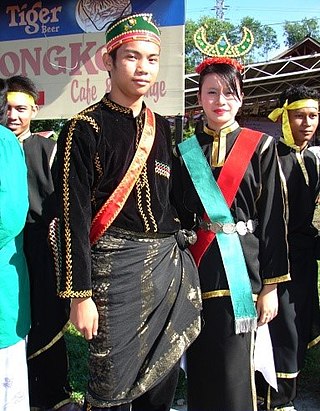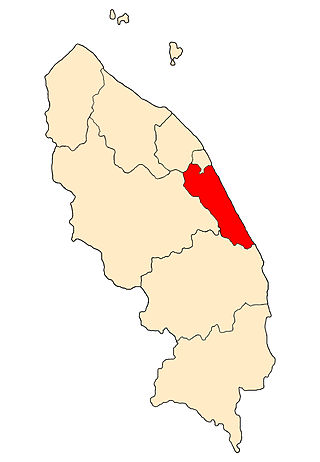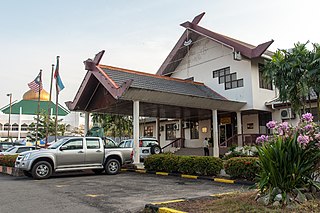
The demographics of Malaysia are represented by the multiple ethnic groups that exist in the country. The official estimate of 2024 Malaysia's population is about 34,100,000 people. According to the 2020 census, is 32,447,385 including non-citizens, which makes it the 43rd most populated country in the world. Of these, 5.72 million live in East Malaysia and 22.5 million live in Peninsular Malaysia. The population distribution is uneven, with some 79% of its citizens concentrated in Peninsular Malaysia, which has an area of 131,598 square kilometres (50,810.27 sq mi), constituting under 40% of the total area of Malaysia.

Terengganu is a sultanate and federal state of Malaysia. The state is also known by its Arabic honorific, Dāru l-Īmān. The coastal city of Kuala Terengganu, at the mouth of the Terengganu River, is both the state and royal capital as well as the most populous city in Terengganu. Other major cities and towns include Jerteh, Kuala Dungun, Chukai, Kuala Berang, Marang, and Permaisuri. At 13,035 square kilometres in size and a population of over 1.2 million people in 2023, Terengganu is Malaysia's 7th largest state and 10th most populated. Terengganu, along with Kelantan, Perlis, and the Federal Territory of Putrajaya, is one of the most homogeneous states/territories in the country of which 95% of the population are ethnic Malay-Muslims with its own distinct language/dialect, culture, history, and tradition.

The Kadazans are an ethnic group indigenous to the state of Sabah in Malaysia. They are found mainly in Penampang on the west coast of Sabah, the surrounding locales, and various locations in the interior.

Papar is the capital of the Papar District in the West Coast Division of Sabah, Malaysia. Its population was estimated to be around 124,420 in 2010, which is divided between Bruneian Malay, Kadazan-Dusun, and Bajau. There is also a sizeable Chinese minority, predominantly of the Hakka subgroup, as well as smaller numbers of other races. The town is located 38 kilometres south of the state capital of Kota Kinabalu, with the Papar railway station in the town becoming one of the main stops of the Sabah State Railway.

The Interior Division is an administrative division of the state of Sabah, Malaysia. It occupies the southwest portion of Sabah, bordered by the neighbouring state of Sarawak on its west. With an area of 18,298 square kilometres, it covers 24.9% of Sabah's territory and is home to approximately 14.7% of Sabah's total population. The largest town in the Interior Division is Keningau. Other main towns in this division include Beaufort, Kuala Penyu, Sipitang, Tambunan and Tenom.

Keningau is the capital of the Keningau District in the Interior Division of Sabah, Malaysia. It is the fifth-largest town in Sabah, as well one of the oldest. Keningau is between Tambunan and Tenom. The town had an estimated population of 173,130. Dusuns and Muruts are the major ethnic groups in Keningau.

Kadazandusun are the largest ethnic group in Sabah, Malaysia, an amalgamation of the closely related indigenous Kadazan and Dusun peoples. "Kadazandusun" is an umbrella term that encompasses both the Kadazan and Dusun peoples. They are also known as Mamasok Sabah, meaning "indigenous people of Sabah". Kadazandusun tradition holds that they are the descendants of Nunuk Ragang. Kadazandusun is recognised as an indigenous nation of Borneo with documented heritage by the United Nations Educational, Scientific and Cultural Organization (UNESCO) since 2004. Kadazandusuns are part of the bumiputera in Malaysia having been endowed with rights concerning land, rivers, education and maintaining their own customary laws.

Bisaya is an indigenous people from the northwest coast of East Malaysia on the island of Borneo. Their population is concentrated around Beaufort as well as Kuala Penyu districts of southern Sabah, Labuan Federal Territory and in Limbang District, Sarawak. The Bisaya tribe has many similarities with the Dusun Tatana tribe, especially in terms of language. It is evident that some of their dialogical language conversations are almost identical if they have a dialogue with each other. Nowadays the Bisaya living in Sabah are Muslims, while the Bisaya living in Sarawak are mostly Christians. In Brunei, they are referred as Dusun, Jati Dusun and Bisaya. The Bisaya is closely related, linguistically, with the Tatana Dusun of Kuala Penyu, Sabah.

The Marang District is a coastal district in Terengganu, Malaysia. The district seat is the town of Marang. The districts that border Marang are Kuala Terengganu and Kuala Nerus to the north, Hulu Terengganu in the west, while Dungun is in the south. The eastern part of the district is a stretch of coastline facing the South China Sea.
Perak Malay is one of the Malay dialects spoken within the state of Perak, Malaysia. Although it is neither the official language nor the standard dialect in the whole state of Perak, its existence which co-exists with other major dialects in the state of Perak still plays an important role in maintaining the identity of Perak. In spite of the fact that there are five main dialects traditionally spoken in Perak, only one of which is intended by the name "Perak Malay". There are subtle phonetic, syntactic and lexical distinctions from other major Malay dialects. Perak Malay can be divided into two sub-dialects, Kuala Kangsar and Perak Tengah, named after the daerah (districts) where they are predominantly spoken.

Sabah is the third most populous state in Malaysia, with a population of 3,418,785 according to the 2020 Malaysian census. It also has the highest non-citizen population, at 810,443. Although Malaysia is one of the least densely populated countries in Asia, Sabah is particularly sparsely populated. Most of the population is concentrated along coastal areas, with towns and urban centres seeing the most population growth.

The Beaufort District is an administrative district in the Malaysian state of Sabah, part of the Interior Division which includes the districts of Beaufort, Keningau, Kuala Penyu, Nabawan, Sipitang, Tambunan and Tenom. The population of Beaufort is composed mainly of Bisaya, Brunei Malays, Kadazan-Dusuns, Lun Bawang/Lun Dayeh, Muruts and Chinese.

The Keningau District is an administrative district in the Malaysian state of Sabah, part of the Interior Division which includes the districts of Beaufort, Keningau, Kuala Penyu, Nabawan, Sipitang, Tambunan and Tenom. The capital of the district is in Keningau Town. The town comprises a majority native Dusun as well as Murut population with significant Chinese minorities.

The Kuala Penyu District is an administrative district in the Malaysian state of Sabah, part of the Interior Division which includes the districts of Beaufort, Keningau, Kuala Penyu, Nabawan, Sipitang, Tambunan and Tenom. The capital of the district is in Kuala Penyu Town.

The Tambunan District is an administrative district in the Malaysian state of Sabah, part of the Interior Division which includes the districts of Beaufort, Keningau, Kuala Penyu, Nabawan, Sipitang, Tambunan and Tenom. The capital of the district is in Tambunan Town.

The Tenom District is an administrative district in the Malaysian state of Sabah, part of the Interior Division which includes the districts of Beaufort, Keningau, Kuala Penyu, Nabawan, Sipitang, Tambunan and Tenom. The capital of the district is in Tenom Town.Majority Tenom is Murut while Kadazandusun as well as Lundayeh are minorities in Tenom.

The Pitas District is an administrative district in the Malaysian state of Sabah, part of the Kudat Division which includes the districts of Kota Marudu, Kudat and Pitas. The capital of the district is in Pitas Town.

The Putatan district is an administrative district in the Malaysian state of Sabah, part of the West Coast Division which includes the districts of Kota Belud, Kota Kinabalu, Papar, Penampang, Ranau and Tuaran. The capital of the district is in Putatan Town.
Cornelius Piong is a Malaysian prelate of the Catholic Church. He became Bishop of Keningau in 1993.
Matbali bin Haji Musah is a Malaysian politician who has served as the Member of Parliament (MP) for Sipitang since November 2022. He served as Member of the Sabah State Legislative Assembly (MLA) for Lumadan from May 2018 to September 2020. He is a direct member of the Gabungan Rakyat Sabah (GRS) and was a member and the Division Chief of Sipitang of the Malaysian United Indigenous Party of Sabah, a component party of the GRS coalition and branch of the component party of the Perikatan Nasional (PN) coalition and was a member and Division Deputy Chief of Sipitang of the United Malays National Organisation of Sabah, a branch of the component party of the Barisan Nasional (BN) coalition. He is an ethnic Bisayan, a sub-ethnic group or tribe of the indigenous Kadazan-Dusun population native to Beaufort and Kuala Penyu districts located in the southern part of Sabah.




















